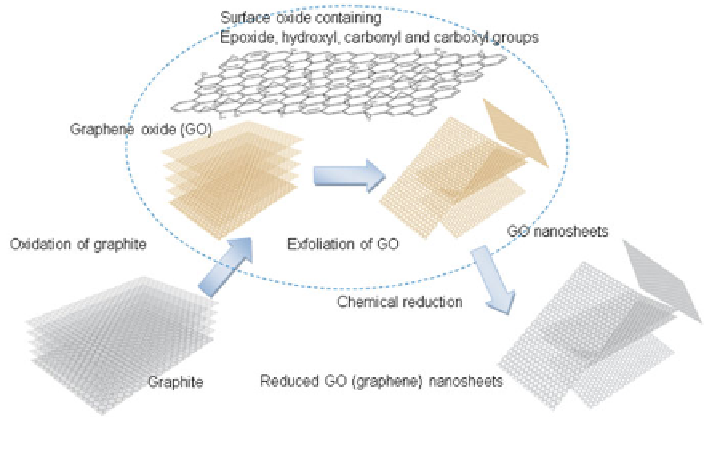Environmental Engineering Reference
In-Depth Information
Fig. 2
Illustration of the production of graphene from the graphite oxidation route
apparatus, and accurate control over operating, which hindered the large-scale
manufacturing of graphene. Instead of the high-cost methods for generating
graphene, the production of graphene sheets by oxidative exfoliation of graphite
and subsequent reduction (Fig.
2
) can offer the high-volume production of RGO
(graphene) [
42
]. Furthermore, functionalized graphene materials are highly dis-
persible in a wide range of solvents, make it easy processable and can be
assembled into various desired macroscopic structures or incorporated with other
nanomaterials into functional composites [
32
,
41
,
44
,
47
]. Although graphene
materials produced by the chemical route possess such advantages, they are still
far inferior to products prepared by mechanical cleavage or CVD due to the high
density of plane defect, which may be undesirable for some technological appli-
cations such as in electronics. However, the defects induced by the chemical
process can provide chemical active sites on the graphene surface, which may
enhance the performance of graphene in the application where high chemical
activity is required, combined with its low cost and large yield, the chemical
reduction generated graphene is especially suitable in the area of energy storage,
catalyst, and chemical sensors, etc.
Recently, Ruoff and Wallace et al. demonstrated that vacuum filtration of the
as-prepared GO or graphene dispersion can result in the formation of free-standing
paper-like materials exhibiting smooth surfaces, which can be called graphene
paper (GO paper) or film [
44
,
48
]. A typical graphene paper possesses a layered
structure through the entire cross section (SEM image in Fig.
3
a) [
49
]. And in X-
ray diffraction pattern, the graphene paper obtained by vacuum filtration displayed
a weak, broad diffraction peak of at about 2h = 23 (Fig.
3
b), which corresponds
to a layer-layer distance (d-spacing) of 0.379 nm, such value is a little larger than

Search WWH ::

Custom Search